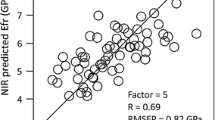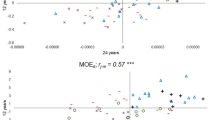Abstract
Douglas-fir (Pseudotsuga menziesii (Mirbel) Franco) is the most important commercial timber species in the United States Pacific Northwest (US PNW). Owing to its significance, Douglas-fir has been the subject of long-term tree improvement. First-generation and second-generation progeny tests are available for wood property evaluation, but aside from specific gravity (from increment cores) and stiffness (usually determined on standing trees using acoustics), the estimation of genetic parameters has been limited. There is interest in evaluating trees for wood stiffness, but the cost of evaluation is generally a barrier. Near infrared hyperspectral imaging (NIR-HSI) may provide a rapid technique for the estimation of a variety of wood properties, providing wood property data is available for building predictive models. In this study, SilviScan was used to assess tracheid properties (wall thickness, coarseness, specific surface and radial and tangential diameter), air-dry density, microfibril angle (MFA) and stiffness for 40 calibration samples, 20 each from two progeny tests aged ten and twelve years, respectively (500 samples in all, one test site from each of two independent first-generation breeding programs). Wood properties were measured on sections of increment cores representing the five growth rings adjacent to the bark. Based on the NIR-HSI and SilviScan data from the 40 calibration samples, models were built to predict wood properties of all samples. These data were used to estimate heritabilities and trait-to-trait genetic correlations. Results from this preliminary study are encouraging and the technique can be explored on larger, multi-site, datasets.




Similar content being viewed by others
Notes
Wavelength range of NIR-HSI systems is typically 900–1700 m, short-wave infrared hyperspectral imaging (SWIR-HSI) systems have the full NIR range (1000–2500 nm).
References
Brawner JT, Meder R, Dieters M, Lee DJ (2012) Selection of Corymbia citriodora for pulp productivity. South for 74(2):121–131
Evans R (1994) Rapid measurement of the transverse dimensions of tracheids in radial wood sections from Pinus radiata. Holzforschung 48(2):168–172
Evans R (1999) A variance approach to the x-ray diffractometric estimation of microfibril angle in wood. Appita J 52(283–289):294
Evans R (1998) Rapid scanning of microfibril angle in increment cores by x-ray diffractometry. In: Microfibril Angle in Wood. Proceedings of the IAWA / IUFRO International Workshop on the Significance of Microfibril Angle to Wood Quality, Westport New Zealand, 21–25 1997, Ed BG Butterfield. University of Canterbury Press: 116–139
Evans R (2006) Wood stiffness by X-ray diffractometry. In Characterization of the Cellulosic Cell Wall. In: Proceedings of the workshop, Grand Lake Colorado USA, 25–27 August 2003, Eds DD Stokke, LH Groom. Blackwell Publishing, Ames, Iowa
Falconer DS, Mackay TFC (1996) Introduction to quantitative genetics. Longman, New York
Gilmour A, Gogel B, Cullis B, Welham S, Thompson R, Butler D, Harding SAS (2021). User guide release 42 functional specification. VSN International Ltd., Amberside House, Wood Lane, Paradise Industrial Estate: Hemel Hempstead, UK.
Hardner CM, Healey AL, Downes G, Herberling M, Gore PL (2016) Improving prediction accuracy and selection of open-pollinated seed-lots in Eucalyptus dunnii Maiden using a multivariate mixed model approach. Ann for Sci 73(4):1035–1046
Howe G, Jayawickrama K, Johnson GR, Cherry M, Wheeler, NC (2005) Breeding Douglas-fir. In: Plant Breeding Reviews, v 27, Ed J Janick. John Wiley and Sons Inc:245–353
Hung TD, Brawner JT, Meder R, Lee DJ, Southerton SG, Thinh HH, Dieters MJ (2015) Estimates of genetic parameters for growth and wood properties in Eucalyptus pellita F. Muell to support tree breeding in Vietnam. Ann for Sci 72(2):205–217
Jayawickrama KJS, Ye TZ (2021) Heritability and type B genetic correlation estimates for coastal douglas-fir in the US Pacific Northwest: trends and insights from 906 first-generation and second-cycle tests. Scand J for Res 36(2–3):83–97
Jayawickrama KJS, Ye TZ, Howe G (2010) Heritabilities, intertrait genetic correlations, G × E interaction and predicted genetic gains for acoustic velocity in mid-rotation coastal Douglas fir. Silvae Genetica 60(1):8–18
Jayawickrama KJS, Ye TZ, Gupta R, Cherry ML (2009) Including wood stiffness in tree improvement of coastal Douglas-fir in the US Pacific northwest: A literature review and synthesis. Research Contribution 50 Forest Research Laboratory, College of Forestry, Oregon State University, Corvallis, OR
Kennard RW, Stone LA (1969) Computer aided design of experiments. Technometrics 11(1):137–148
Keyer K (1989) Estimations of genetic parameters. In Evolution and animal breeding: Reviews on molecular and quantitative approaches in honour of Alan Robertson, Eds Hill WG, Mackay TFC. CAB International, Wallingford, UK
Ma T, Inagaki T, Tsuchikawa S (2017) Calibration of SilviScan data of Cryptomeria japonica wood concerning density and microfibril angles with NIR hyperspectral imaging with high spatial resolution. Holzforschung 71:341–347
Ma T, Inagaki T, Tsuchikawa S (2018) Non-destructive evaluation of wood stiffness and fiber coarseness, derived from SilviScan data, via near infrared hyperspectral imaging. J near Infrared Spectrosc 26:398–405
Ma T, Schimleck L, Dahlen J, Yoon S-C, Inagaki T, Tsuchikawa S, Sandak A, Sandak J (2022) Comparative performance of NIR-Hyperspectral imaging systems. Foundations 2:523–540
Meyer K, Thompson R (1984) Bias in variance and covariance component estimators due to selection on a correlated trait. J Anim Breed Genet 101:33–50
Mora C, Schimleck LR (2008) On the selection of samples for multivariate regression analysis: application to near infrared (NIR) calibration models. Can J for Res 38(10):2626–2634
Perez DD, Guillemain A, Alazard P, Plomion C, Rozenberg P, Rodrigues JC, Alves A, Chantre G (2007) Improvement of Pinus pinaster Ait elite trees selection by combining near infrared spectroscopy and genetic tools. Holzforschung 61(6):611–622
Poke FS, Raymond CA (2006) Predicting extractives, lignin, and cellulose contents using near infrared spectroscopy on solid wood in Eucalyptus globulus. J Wood Chem Technol 26(2):187–199
Raymond C, Schimleck L (2002) Development of near infrared reflectance analysis calibrations for estimating genetic parameters for cellulose content in Eucalyptus globulus. Can J for Res 32(1):170–176
Raymond C, Schimleck L, Muneri A, Michell AJ (2001) Genetic parameters and genotype-by-environment interactions for pulp yield predicted using near infrared reflectance analysis and pulp productivity in Eucalyptus globulus. For Genet (Zvolen) 8(3):213–224
Schimleck LR, Evans R (2004) Estimation of P. radiata D.Don tracheid morphological characteristics by near infrared spectroscopy. Holzforschung 58(1):66–73
Schimleck L, Kube PD, Raymond C (2004) Genetic improvement of kraft pulp yield in Eucalyptus nitens using cellulose content determined by near infrared spectroscopy. Can J for Res 34(11):2363–2370
Schimleck LR, Mora CR, Jordan L, White DE, Courchene CE, Purnell RC (2009) Determination of within tree variation of Pinus taeda wood properties by near infrared spectroscopy. Part 1: development of multiple height calibrations. Appita J 62:130–136
Schimleck L, Dahlen J, Apiolaza LA, Downes G, Emms G, Evans R, Wang X (2019) Non-destructive evaluation techniques and what they tell us about wood property variation. Forests 10(9):728
Schimleck L, Antony F, Mora C, Dahlen J (2020a) Whole-tree tracheid property maps for loblolly pine at different ages. Wood Sci Technol 54(3):683–701
Schimleck L, Matos JLM, Higa AR, Trianoski R, Prata JG, Dahlen J (2020b) Classifying wood properties of loblolly pine grown in southern Brazil using NIR-hyperspectral imaging. Forests 11(6):686
Schimleck L, Ma T, Inagaki T, Tsuchikawa S (2023) Review of near infrared hyperspectral imaging applications related to wood and wood products. Appl Spectrosc Rev. https://doi.org/10.1080/05704928.2022.2098759:25pages
Schimleck LR, Tsuchikawa S (2021) Application of NIR spectroscopy to wood and wood derived products. In The Handbook of Near-Infrared Analysis, Fourth Edition. Eds EW Ciurczak, B Igne, J Workman, DA Burns. CRC Press Boca Raton Florida: 759–780
Snee RD (1977) Validation of regression models: methods and examples. Technometrics 19(4):415–428
Stackpole DJ, Vaillancourt RE, Downes GM, Potts HCE, BM, (2010) Genetic control of kraft pulp yield in Eucalyptus globulus. Can J for Res 40(5):917–927
Stackpole DJ, Vaillancourt RE, Alves A, Rodrigues J, Potts BM (2011) Genetic variation in the chemical components of Eucalyptus globulus wood. G3 Genes Genom Genet 1(2):151–159
Varghese M, Harwood CE, Bush DJ, Baltunis B, Kamalakannan R, Suraj PG, Hegde D, Meder R (2017) Growth and wood properties of natural provenances, local seed sources and clones of Eucalyptus camaldulensis in southern India: implications for breeding and deployment. New Forest 48(1):67–82
Viet DD, Ma T, Inagaki T, Kim NT, Tsuchikawa S (2020) Physical and mechanical properties of fast growing polyploid acacia hybrids (A. auriculiformis × A. mangium) from Vietnam. Forests 11(7):717
Viet DD, Ma T, Inagaki T, Kim NT, Tsuchikawa S (2021) Near-infrared spectroscopy and hyperspectral imaging can aid in the prediction and mapping of polyploid acacia hybrid wood properties in tree improvement programs. Holzforschung 75(12):1067–1080
White T (1996) Genetic parameter estimates and breeding value predictions: issues and implications in tree improvement programs. In Tree improvement for sustainable tropical forestry. Proc the QFRI IUFRO Conf, Caloundra Queensland Australia 1996:110–117
Acknowledgements
The wood samples were provided by the Nehalem and Vernonia Southeast cooperatives; specific gravity data were also provided for the cores. This work would not have been possible without the large investment by the cooperators over many years in establishing, maintaining and measuring the test sites, analyzing data, and eventually taking cores.
Author information
Authors and Affiliations
Contributions
L.S. and K.J. wrote the main manuscript text. L.S. conducted the hyperspectral imaging and wood property estimation. T.Y. determined genetic parameters and prepared figures 2-4 and tables 3-8. All authors reviewed the manuscript.
Corresponding author
Ethics declarations
Competing interests
The authors declare no competing interests.
Additional information
Publisher's Note
Springer Nature remains neutral with regard to jurisdictional claims in published maps and institutional affiliations.
Rights and permissions
Springer Nature or its licensor (e.g. a society or other partner) holds exclusive rights to this article under a publishing agreement with the author(s) or other rightsholder(s); author self-archiving of the accepted manuscript version of this article is solely governed by the terms of such publishing agreement and applicable law.
About this article
Cite this article
Schimleck, L.R., Jayawickrama, K.J.S. & Ye, T.Z. Wood property genetic parameter estimation from first-generation Douglas-fir progeny tests. Wood Sci Technol 58, 295–312 (2024). https://doi.org/10.1007/s00226-023-01516-z
Received:
Accepted:
Published:
Issue Date:
DOI: https://doi.org/10.1007/s00226-023-01516-z




